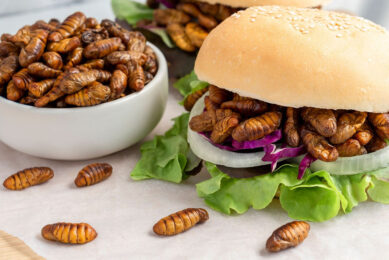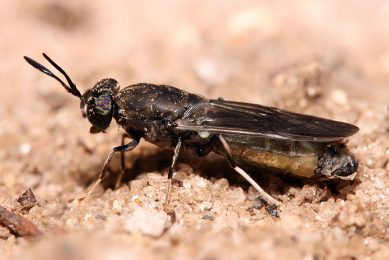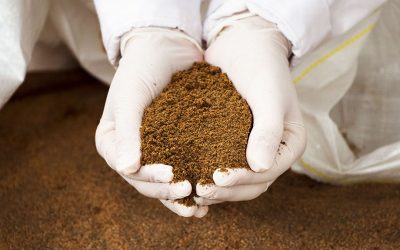Insects: its value for pig, poultry and fish diets

The use of insect meal, derived from larvae, in animal diets is promising. But what is the nutritional value of this protein? A paper by Harinder Makkar reviewed 5 major insect species and their value for different animal species. Here we discuss the Black Soldier Fly.
Black soldier fly larvae are used live, chopped, or dried and ground. The larvae can feed quickly, from 25 to 500 mg of fresh matter/larva/day, and on a wide range of decaying organic materials and manure.
Use in pig diets needs AA balance
Black soldier larvae meal was found to be a suitable ingredient in growing pig diets, being especially valuable for its amino acid, lipid and Ca contents. However, its relative deficiency in methionine + cystine and threonine requires the inclusion of those amino acids (AA) for the preparation of balanced diets. The ash content of the meal is also high and this requires attention. The diets containing the larvae meal were as palatable as a soymeal based diet (Newton et al., 1977)
Trial with AA supplementation
In a trial, dried black soldier fly prepupae meal was fed to early weaned pigs as a replacement (0, 50, or 100%) for dried plasma (meal in the diet: 0% during phase 1, 2.5% during phase 2, and 5% during phase 3), with or without amino acid supplementation. Without amino acid supplementation, the 50% replacement diet gave slightly better performance during phase 1 (+4% gain, +9% feed efficiency). However, the 100% replacement diets did not perform as well as the control (overall performance reduced by 3 to 13%). Additional refinement (cuticle removal and rendering) may be necessary to make black soldier fly prepupae meal suitable for early weaned pigs (Newton et al., 2005)
Support growth in chicks
As a component of a complete diet, black soldier fly larvae meal has been found to support good growth in chicks. Chicks fed a diet containing dried black soldier fly larvae (as a substitute for soymeal) gained weight at a rate 96% (non-significant) of that of chicks fed the control diet containing soymeal, but they only consumed 93% (significant) as much feed (Hale, 1973 cited by Newton et al., 2005), suggesting higher feed conversion efficiency of diet containing the larvae meal.
Also read: Norway to invest in insect use for aquafeed
Good results in fish diets
Several experiments have shown that black soldier fly larvae could partially or fully substitute for fishmeal in fish diets. However, additional trials as well as economic analyses are necessary because reduced performance has been observed in some cases, and the type of rearing substrate and the processing method affect the utilization of the larvae by fish.
Trout and Atlantic salmon trials
For example, dried ground black soldier fly prepupae reared on dairy cattle manure enriched with 25–50% trout offal could be used to replace up to 50% of fishmeal protein in trout diets for 8 weeks without significantly affecting fish growth or the sensory quality of trout fillets, though a slight (but non-significant) reduction in growth was observed (Sealey et al., 2011). In a 9-week study, replacing 25% of the fishmeal protein in rainbow trout diets with black soldier fly prepupae meal (reared on pig manure) did not affect weight gain and feed conversion ratio (St-Hilaire et al., 2007a). In Atlantic salmon, a control diet containing 200 g/kg fishmeal (FM) was stepwise replaced by insect meal (black soldier fly larvae) at 25%, 50% or 100% FM replacement. Insect meal containing diets performed equally well as the FM group and increase in feed conversion efficiency was observed. Histology did not show any differences between any of the dietary groups and sensory testing of fillets did not reveal any significant difference (Lock et al., 2014). However, these authors did caution that the method of preparation of insect meal could impact performance.
Source: Journal of Animal Feed Science and Technology











